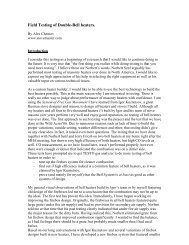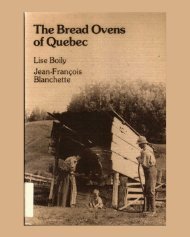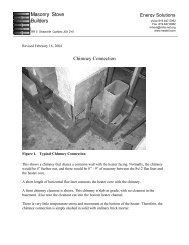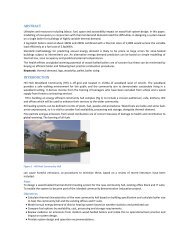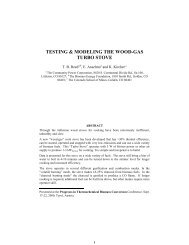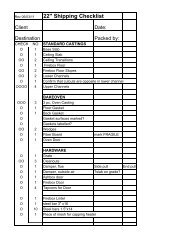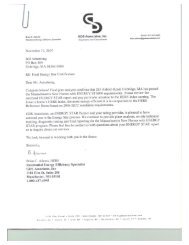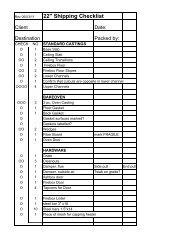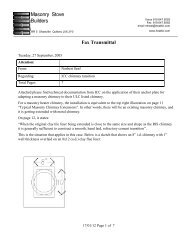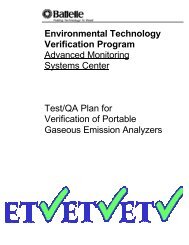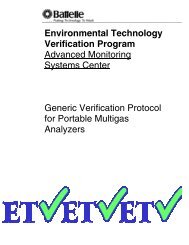96-TA28.07 The Hearth as an Element of the Sustainable House - A ...
96-TA28.07 The Hearth as an Element of the Sustainable House - A ...
96-TA28.07 The Hearth as an Element of the Sustainable House - A ...
You also want an ePaper? Increase the reach of your titles
YUMPU automatically turns print PDFs into web optimized ePapers that Google loves.
<strong>96</strong>-<strong>TA28.07</strong><br />
jurisdiction for progressive environmental regulation, is implementing state Cle<strong>an</strong> Air<br />
Act requirements with state Building Code regulations requiring particulate emissions<br />
certification for new m<strong>as</strong>onry fireplaces <strong>as</strong> well <strong>as</strong> factory-built fireplaces <strong>as</strong> <strong>of</strong> J<strong>an</strong>uary<br />
1, 1997. 4<br />
Sustainability h<strong>as</strong> <strong>an</strong> intuitive appeal, but a precise definition h<strong>as</strong> not yet had <strong>the</strong><br />
opportunity to st<strong>an</strong>d <strong>the</strong> test <strong>of</strong> time. G<strong>as</strong> fireplaces, for example, are currently enjoying<br />
<strong>the</strong> favor <strong>of</strong> consumers <strong>an</strong>d some environmental advocates. This is b<strong>as</strong>ed partially, no<br />
doubt, on <strong>an</strong> industry advertising campaign <strong>of</strong>fering re<strong>as</strong>sur<strong>an</strong>ces that burning natural g<strong>as</strong><br />
is “<strong>the</strong> right thing for <strong>the</strong> environment”. What, <strong>the</strong>n, is sustainability? And how do we<br />
define a “sustainable” fireplace?<br />
<strong>The</strong> First International Conference on <strong>Sustainable</strong> Construction took place in 1994 5 , <strong>an</strong>d<br />
defining sustainability occupied two <strong>of</strong> <strong>the</strong> fifteen sessions. Conference coordinator<br />
Charles Kibert noted that <strong>the</strong> concept <strong>of</strong> sustainability is not a new one. It became part <strong>of</strong><br />
<strong>the</strong> environmental vernacular in 1987 when <strong>the</strong> Brundtl<strong>an</strong>d Report described<br />
sustainability <strong>as</strong> “leaving sufficient resources for future generations to have a quality <strong>of</strong><br />
life similar to ours.”<br />
Dr. Kibert makes a comparison <strong>of</strong> <strong>the</strong> traditional building construction criteria <strong>of</strong><br />
perform<strong>an</strong>ce, quality <strong>an</strong>d cost with sustainability criteria <strong>of</strong> resource depletion,<br />
environmental degradation, <strong>an</strong>d a healthy environment. This is summarized in Table 1.<br />
This suggests a context for fireplace emissions research. If we start by attempting to<br />
define a generalized set <strong>of</strong> sustainability criteria, we may <strong>the</strong>n use <strong>the</strong>se criteria to<br />
identify specific research t<strong>as</strong>ks that may inform regulation.<br />
Table 2 uses Kibert’s traditional criteria to compare a conventional wood burning<br />
m<strong>as</strong>onry fireplace with <strong>an</strong> adv<strong>an</strong>ced combustion wood burning m<strong>as</strong>onry fireplace <strong>an</strong>d<br />
with a zero clear<strong>an</strong>ce g<strong>as</strong> fireplace. Table 3 uses Kibert’s sustainability criteria for <strong>the</strong><br />
same comparison.<br />
We note that <strong>the</strong> conventional criterion <strong>of</strong> installed cost is currently perhaps <strong>the</strong> overiding<br />
factor in fireplace specification by <strong>the</strong> housebuilding industry. Convenient “push button”<br />
operation is perhaps a secondary, perform<strong>an</strong>ce, criterion.<br />
Examining <strong>the</strong> sustainability criteria, we note that obvious m<strong>as</strong>onry fireplace adv<strong>an</strong>tages<br />
such <strong>as</strong> long lifecycle <strong>an</strong>d <strong>the</strong> potential for reusability <strong>of</strong> materials are not recognized by<br />
current housing cost accounting methods. Discounted c<strong>as</strong>h flow accounting places a<br />
premium on capital cost <strong>an</strong>d h<strong>as</strong> little regard for lifecycle costs, let alone environmental<br />
impacts. By <strong>the</strong> same token, <strong>the</strong> st<strong>an</strong>dard high emissions, low efficiency fireplace pays no<br />
penalty. Nei<strong>the</strong>r does <strong>the</strong> fossil fueled g<strong>as</strong> fireplace.<br />
This is admittedly a tentative <strong>an</strong>alysis <strong>an</strong>d reflects <strong>the</strong> fact that explicit regard for<br />
sustainability criteria is a new <strong>an</strong>d evolving trend in <strong>the</strong> housing field.<br />
Moving Towards Sustainability<br />
<strong>The</strong> ability to use minimally processed, locally grown fuel for domestic heating is a<br />
realistic option in m<strong>an</strong>y locales on this continent. <strong>The</strong>re is a caveat attached to firewood<br />
use, however. Grown, harvested or burned improperly, it c<strong>an</strong> also become <strong>an</strong><br />
environmental liability.<br />
3



